David Daigle, former special forces and Norwegian climbing champion, owner of DID Extreme Expeditions, adventure travel expert, and all-round good guy, is the owner behind today’s featured vehicle, a Toyota Hilux Arctic Truck 38 Polar Edition.
I first met David in southern Norway during a road trip to Stavanger, and if I’m honest, nearly came off the road when I passed his monster Hilux and overland trailer. Obviously, in the words of Boromir, “one does not simply pass a heavily modified overland rig.” Thus, I pulled in and introduced myself. David was a total gentleman, showing me around his truck, sharing what he was up to, and kindly offering to show me the way over the mountain after discussing my plans. I jumped in the van with the guys and realised immediately that, in order to follow his monster Hilux, the Syncro was about to get the toughest workout of its life. We were in hysterics as my speedo dropped rapidly on the ascent, while the Hilux, fully loaded with multiple passengers and a large overland trailer, effortlessly pulled away (despite David clearly going as slow as possible). We finally reached our destination, pulled over, and watched in awe as David disappeared up a super-steep dirt track. I think at that moment, we all secretly hoped he was going to adopt one of us.
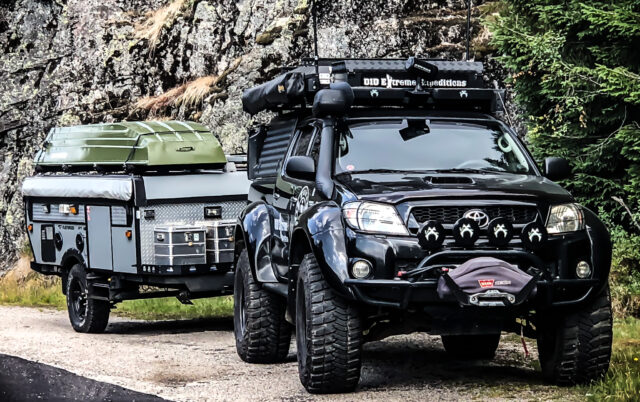
David has since become a friend and a source of inspiration for my own travels. I love that his emphasis is always on the experience, and whilst his rig and overland accessories are impressive, he simply views them as means to get back to nature. Finally, Arctic Trucks, as the name suggests, are generally synonymous with cold climates, and David certainly makes the most of this. However, he was also the first in Norway to demonstrate the performance of an Arctic Truck in Africa, thus making this a truly fascinating case study.
From the Owner:
“I was born 1980 in Norway, but in 1989 I moved to Wimbledon in the United Kingdom for my dad’s work (he’s American) where we lived for three years. I was already very active and doing gymnastics, but when we moved to the UK, there weren’t any local clubs for me to join. The school took us to Wales for an outdoor adventure camp, kayaking and rappelling. The latter I really enjoyed, because even as a kid, I was pretending I was a commando. The teachers told my parents I had a natural talent for the sport and should join a club; this kickstarted my love of climbing. When I returned to Norway, the only local club was for serious climbers, and I was just a kid, but I joined, and things progressed quickly. They’d never had a junior represent them in the Norwegian championships, and they wanted me to be the first. In the end, I won the tournament and was scouted by the national team. I was in the world championships in Russia, placing 18 out of 100 and ranked second in Scandinavia. At the time, I was working at an outdoor store in Norway, which led to more adventure sports, such as kayaking, mountaineering, canyoning, etc., whilst also working as a guide. I was in the mountains constantly, and in 2005 I climbed Aconcagua, 22,841 feet (6,962 meters), in Argentina. Following that expedition, I took a step back from climbing so I could pursue dog sledding full-time. I then joined the Norwegian special forces, and when I left, I wanted to settle down. Nonetheless, I needed a way to continue having outdoor adventures and also include my family, and that’s when my love of vehicle overlanding began.
In 2007, I purchased my first Arctic Truck, a Land Cruiser Prado 120 on a 35” build. I then organised my first trip to Morocco in 2011, which generated a considerable amount of backlash. A lot of people said the Arctic Truck was not suitable for an overland trip like this, that I needed a classic Land Cruiser or Defender. In the end, I got tired of all the naysaying and figured I’d get out there and prove them wrong! As I did, the truck had no problems at all.
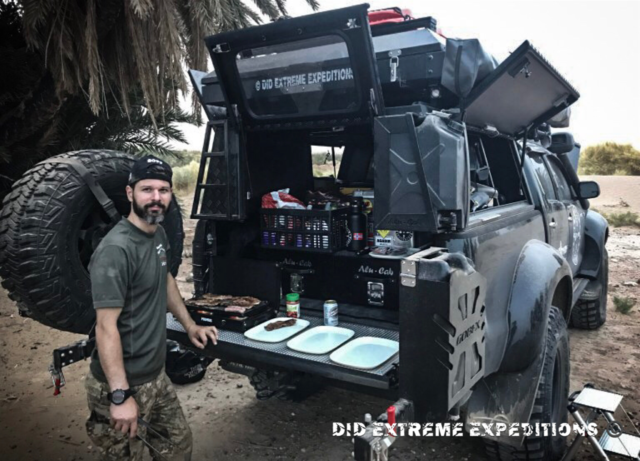
The Build:
Factory Specs:
2006-2011 Toyota Hilux 3.0 D-4D Double Cab (4.98-foot bed)
3.0 turbo-diesel, 169HP, 343 newton-metres torque
Fuel tank, 80 litres (17.6 gallons)
Kerb weight 4,222 pounds
Gross weight 6,029 pounds
Payload 1,807 pounds
Front suspension double wishbone
Rear suspension live axle

“This is the last real breed of the Hilux before they fitted more electrics and arguably compromised overland reliability. I chose this model as I love having the truck bed in the rear; [it’s] a fantastic cargo space, especially when combined with the canopy. The issue with something like a Land Cruiser is you have to store most of the gear inside, which isn’t ideal if you have dirty equipment, wet/smelly clothes, or trash. A truck, like the Hilux, means you’re able to separate these items from the cabin whilst also offering a higher load capacity. The Hilux is 400 kilograms less (dry weight) than a comparable Land Cruiser 120 Prado.
Additionally, Arctic Trucks in Norway only builds the Land Cruiser up to 37-inch tires, whilst the Hilux is built to accommodate 38-inch tires. Here in Norway, that extra inch improves the vehicle’s capability in the snow and provides a much better footprint for traction. The Hilux was also the biggest approved option here in Norway, which has very strict regulations when it comes to modified vehicles.
The overland build-out was completed by myself in 2016 and was the first Arctic Truck to be kitted with Alu-Cab equipment, including a canopy, tent, awning, fridge sliders, and drawers (I played a big role in Alu-Cab then getting involved with Arctic Trucks). Electrics, radio communications, Vision X Lights, an upgraded suspension, a fridge, and water tanks were all fitted by myself. Arctic Trucks chopped off the original suspension brackets, created new ones, lowered them, pushed them forwards, and then cut away the fenders to accommodate the 38-inch tires (this work had to be carried out by them in order for the vehicle to meet Norwegian vehicle laws). It’s a huge job; it takes around a month and a half to complete and will set you back approximately $37,500 (£30,000). This really is the biggest modification to the truck.
Gearing is adjusted, and a speedo converter is fitted to account for the much larger tires. I also opted for ARB air lockers in the front and rear, and to be honest, without them, the truck would just be for show—they make all the difference on technical terrain and snow. My Hilux is a 2010 MK6 model, originally 169 horsepower, but has a Stage One tune that provides 205 horsepower and 410 newton-metres torque, which also helps offset the bigger tires. Interestingly, the front brakes are downgraded from the larger discs ordinarily found on my 3.0L Hilux to the brakes fitted on the 2.5-litre model. This is because the tires on an Arctic Truck are very large, but the rims are actually quite small (15 inches), and the 3.0-litre disc diameter won’t fit. I run 15-inch rims in winter and 17-inch rims during summertime. I have to say that I miss the larger discs found on the 3.0 litre as I often tow a sizeable overland trailer. And on mountain descents, I can definitely feel the limitations of the smaller brakes.”
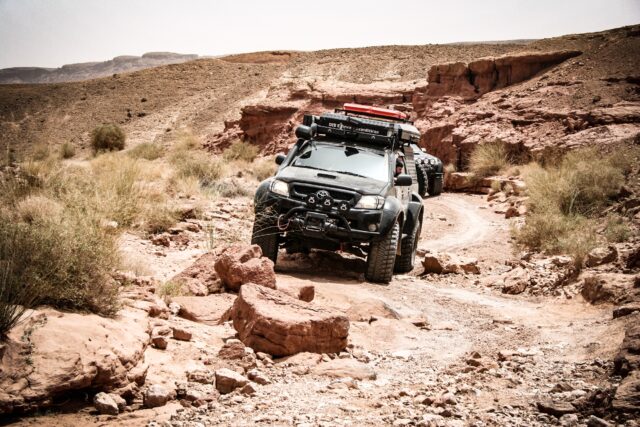
Future Modifications?
David: The Hilux is already so heavily modified at this point, even the small details, that I just want to enjoy it whilst providing thorough maintenance and servicing. I truly feel this is the best possible setup for my expeditions. The vehicle and equipment will only ever give you so much satisfaction; the emphasis has to be put on the travel and experiences. I wanted the best quality gear because I need to be able to depend on it. So I went all-in; that’s always my approach if I truly love something. I usually swap out the leaf springs after a few seasons. I’m running Old Man Emu Dakar leaf springs (8 pack) with a 600+ kilogram payload in conjunction with the Old Man Emu BP51 shocks. I need to depend on them—driving across the dunes, bouncing up and down—with all that cargo. Aside from that, it’s just about taking care of the vehicle and enjoying it.

Camping Setup:
David: There’s an aluminium table integrated into the tailgate for when it’s dropped down, and this is used as my kitchen top for cooking (using a Primus stove). There are slide-out drawers in the bed, which allow easy access to all my gear and food, and for sleeping, I have an Alu-Cab Expeditions 3 roof tent. On the right side of the canopy, I have a kitchen tray where I store all my cookware and utensils. I have a 270-degree awning from Alu-Cab, which means I can cook/relax in comfort, whether it’s hot or raining. I also have a portable charcoal grill as I enjoy this style of cooking, alongside a large Skottle, which is perfect for preparing food for big groups on expeditions (whilst also being quick and easy to clean). It’s important to keep things simple and functional on the road. I want everything to be easily accessible: quick in, quick out (this is particularly important when I’m taking care of clients).
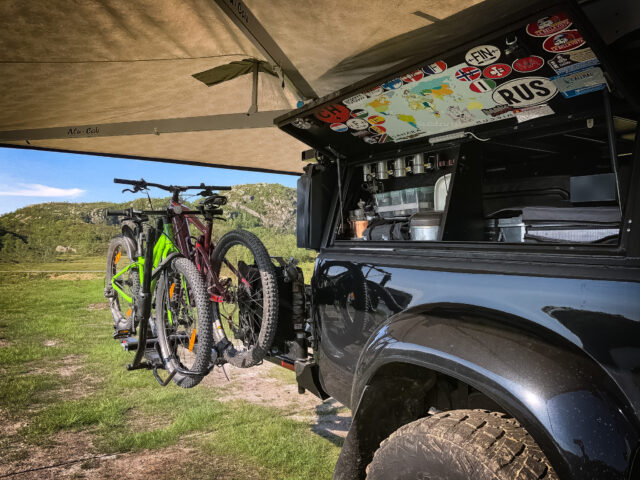
Recovery Gear:
David: One of the big advantages of having such large tires combined with air lockers is that getting really stuck is unusual. I ordinarily run 30 psi in all four tires (Goodyear MTR Kevlar—they’re incredible). If I get stuck, I’m usually able to get out by simply engaging the lockers and airing down. That’s the beauty of the 38-inch tire footprint: huge amounts of traction. If a Land Rover Defender on 32-inch tires gets stuck, I can often just drive through the same spot like it was a tarmac road—that’s the difference it makes. I also run a Warn Zeon Platinum 12 winch, rated to almost 6 tonnes; it’s part of their premium series and is just about the best winch money can buy. I always carry a shovel, of course, but beyond that, my recovery gear is kept fairly minimal. I usually travel with at least one other vehicle on challenging trips, and this makes recovery much easier, i.e., you always have a suitable winching or strap point. If I did find myself in the desert solo and needed to winch out, then I can dig a deep hole, bury my spare wheel, and use that as a land anchor. Sure, many people take more gear than me but completely forget about vehicle weight, and recovery equipment is heavy. I know lots of overlanders who simply don’t use half the equipment they bring. I like to travel light and pack just the things I know I’ll use.
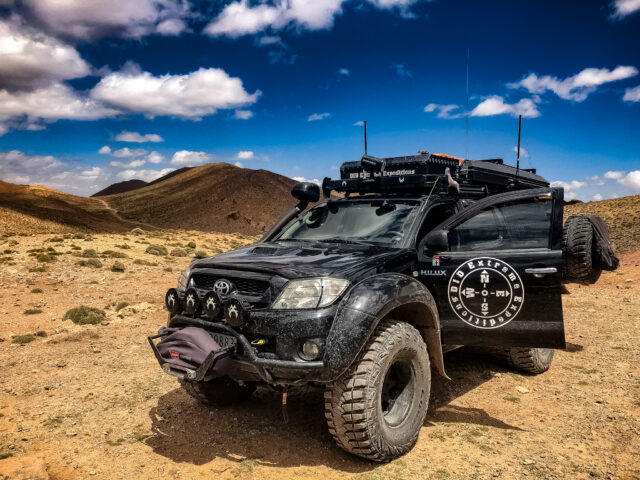
Adventure:
Can you tell me about some of your most exciting overlanding trips?
David: If I had to choose, then I’d say traveling too close to the Algerian border, driving through a minefield, and having a big military convoy racing out to meet us. We explored a lot of the desert, sleeping out in the dunes. I love Morocco because it has everything you want from an overlanding trip: desert, huge dunes, oases, beautiful cities, the Atlas Mountains—in just two weeks you see so much variety. I also love Namibia because of the wildlife, but it’s not as technical to drive, which I miss. Russia is also good, with lots of dense forests and mountains and a very different climate, culture, and society. The variety is what makes trips exciting for me—meeting new people, experiencing different cultures, and sharing stories and knowledge with one another. It’s more about the journey than the destination, the opportunity to meet so many amazing people. It frustrates me when travellers just race to their destination and don’t take a moment to really absorb the surroundings, they miss out on so much.

Any routes that were particularly challenging?
David: That would have to be an experience I had in the Western Sahara trying to access a dune camp. I had a Moroccan friend riding in the cab guiding me, but at the time, I wasn’t hugely experienced driving in the dunes. It’s an environment that needs to be respected as it’s easy to make mistakes, and it doesn’t take much to flip the vehicle. There was no waypoint or tracks, he was just pointing with his hand, and I had to maintain momentum to prevent bogging down. In the end, he got us lost, and we got stuck on a steep dune, very close to tipping. The only recovery option was to gently turn the vehicle and point it straight down. I had to trust his experience, but descending the dune, I was on two wheels. We soon found ourselves in a similar situation, and it was then that I decided it wasn’t worth taking any more risks and thus opted for a much longer but safer route. This experience was definitely one of the most nerve-wracking. On another occasion, I ended up on a military track in Russia, completely overgrown, and it became so technical that I couldn’t back out, so I ended up driving for hours, forcing my way through dense bracken. The Hilux got so scratched on this trail that it required a full respray when I returned to Norway, but, like I’ve mentioned, the truck is there to be used.
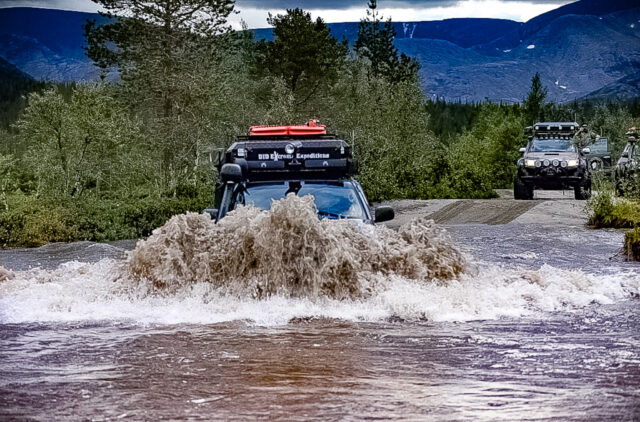
Do you have any words of wisdom for someone considering their first overlanding trip?
David: I’d recommend living out of the vehicle in your home country for two weeks before considering venturing farther afield. In your homeland, you speak the language, know the culture, and amenities are generally close by. It’ll also allow you to trial the rig and figure out what needs to be changed or what’s not practical. Usually, people always overpack, so this is a great opportunity to figure out exactly what you need. It’s a big jump from a weekend trip to a multi-week international adventure, and it’s not uncommon for newcomers to be either underprepared or overprepared. Hence, start small, build up gradually, and take time to decipher what setup works for your objectives. Furthermore, if you’re planning a serious off-grid overland adventure, ensure your preliminary test runs are in the backcountry, away from convenient amenities. It’s important to at least try some degree of self-dependency.

Where can people find you?
Instagram: did_extreme_expeditions
Facebook: didextreme

Specifications
2010, MK6, Toyota Hilux Double Cab
Arctic Trucks 38 Polar Edition
Power
D4D 3.0-litre diesel, Stage One Tune, 205 horsepower, and 410 newton-metres torque
Suspension and Drive
Old Man Emu BP 51 shock absorbers
50-millimetre suspension lift
ARB front and rear air lockers
Front and rear wheelhouse adjustment
Wheel angle adjustment
Reinforcement of spindles
Brake remodelling
New exchange in the front and rear axles 4:88 ratio
Wheels and Tires
Goodyear MTR Kevlar 38/15.5R15 or 38/14.5R17
Arctic Trucks alloy wheels, 15×10 inches or 17×10 inches
Recovery and Armor
Baja Iceland bull bar
Warn Zeon 12s Platinum winch
Gobi-X body protection
24/7 360-degree CCTV and alarm system
2 x Viair 400cc air compressors
Underrun Protection
Accessories
Alu-Cab Adventure canopy
Alu-Cab 270-degree awning
African Outback roof rack
TJM snorkel
Alu-Cab Expeditions 3 roof tent
Alu-Cab double short drawers
Vision X Transporter 18 and Solstice 45-gram auxiliary spots
Gobi-X wheel carrier
Snowmaster Expedition Series 95-litre, Travel 46-litre, and 20-litre fridges
Garmin and Getac/IPAD GPS
Icom 7000i VHF radio
Waeco 4000-watt/240-volt inverter
Iridium Extreme satphone with cradle
Ram custom accessory mounts
Fuel Capacity
Stock fuel tank, 80 litres
ARB long-range fuel tank, 140 litres
Water Capacity
Front Runner 60-litre water tank
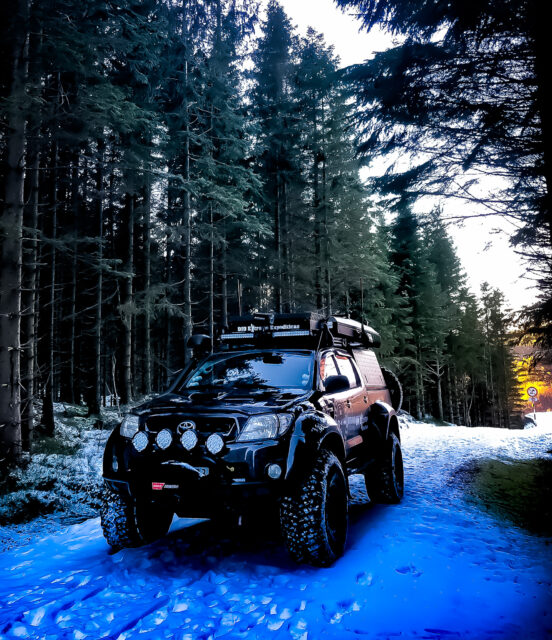
Our No Compromise Clause: We carefully screen all contributors to make sure they are independent and impartial. We never have and never will accept advertorial, and we do not allow advertising to influence our product or destination reviews.


